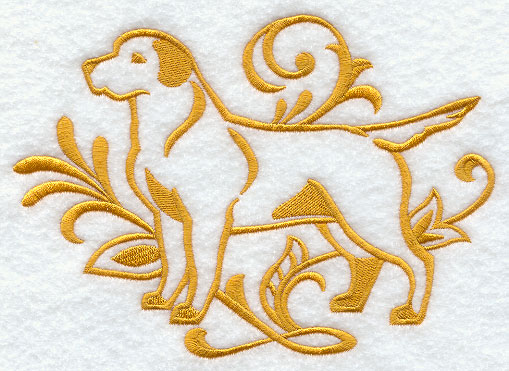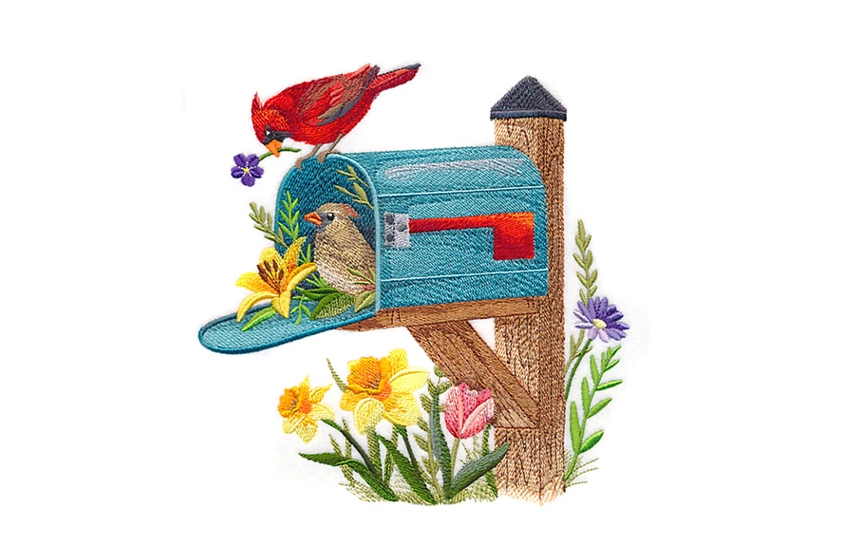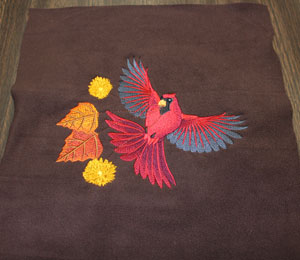
Rugged. Cozy. Durable. Comfy. Cotton chamois has all of these excellent qualities.
It's a soft but sturdy fabric that is perfect for sewing everything from warm quilts and cozy bedding to strong tote bags and rugged seat covers.
Chamois is tough enough to stand up to a lot of use and washing, yet known for its softness in garments and quilts. With this kind of comfort and durability, chamois is an all-around friendly fabric for a variety of different projects!
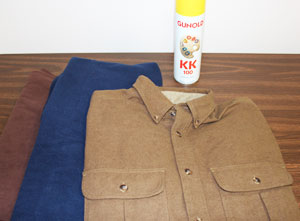
Cotton chamois is commonly used to make shirts and other garments. For example, the durable chamois shirts found in stores specializing in outdoor wear -- such as Cabelas, L.L. Bean, and Eddie Bauer's -- are made from cotton chamois.
Finding chamois on the bolt is pretty hit-or-miss, so I ordered a few colors from Fabrics.com. When it arrived, I was surprised to find how stretchy it was! Then I realized it was polyester chamois, not cotton.
Polyester chamois is even softer than cotton (it reminds me a little of fleece, with a lower nap) and it is much stretchier. This fabric would make wonderful quilts and baby blankets. I was curious to see what kinds of designs would work well on the polyester chamois. Read on to see what I discovered!
Pre-washing is always a good idea, but it's especially important for cotton chamois, since cotton usually shrinks to some degree, so I ran my chamois shirt through the washer and dryer. I pre-washed the polyester chamois as well.
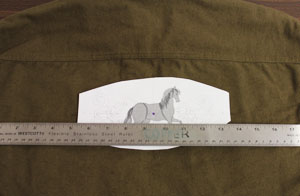
After choosing the Wild Side Horse for the back of my cotton chamois shirt, I made a template of the design. I use templates (printouts of designs) to help me place the design, and hoop the fabric so that the design will be even and straight.
If you don't have a program that can print templates, try Embird or Wilcom's TrueSizer, or Buzz Xplore. Or, stitch a quick sample of the design that you'll be using, and use that to plan where you'll place the design.
I centered the template on the back of the shirt, marked the center point, and marked the design's horizontal and vertical axis lines. This helps me to stitch the design in the right place.
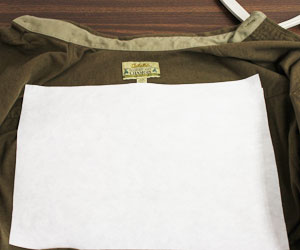
What kind of stabilizer will work best with the cotton chamois? Since cotton chamois is frequently made into items that get lots of wear 'n' tear and wash 'n' wear, cutaway stabilizer is the best option. It offers the most support for the embroidery stitches, and makes the strongest surface for a design to stay great-looking for a long time.
I unbuttoned the shirt completely, sprayed the inside of the shirt with temporary spray adhesive, then smoothed a piece of cutaway stabilizer inside the shirt, making sure to cover the design area.
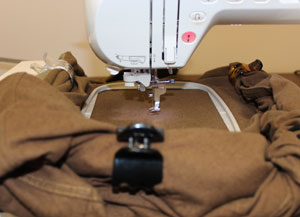
I hooped the shirt with the hoop running horizontally (from sleeve to sleeve). Once I put the hoop on my machine, I rolled the excess material up (make sure you roll up instead of down, to keep the fabric from being pulled under the hoop), and clipped it to keep it out of the way. I used hair clips for this, but chip clips or clothespins will work, too.
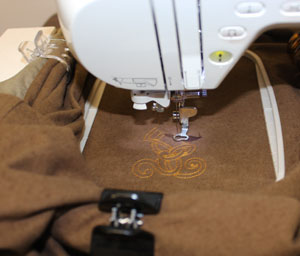
Then I embroidered the design, making sure the fabric behind the machine was allowing the embroidery arm to move freely.
After the design finished, I trimmed the excess stabilizer from the inside of the shirt, leaving about one inch of stabilizer around the design edges.
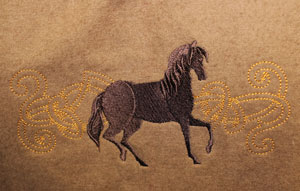
As you can see, this sturdy cotton chamois shirt is perfect for a stitch-filled design, and the more delicate running stitches look great as well.
Cotton chamois is strong enough to support more complex designs, and has a low enough nap to work with lighter designs, such as vintage-style and "sketchy" designs, too. So pick a design you love, and embellish your cotton chamois shirt!
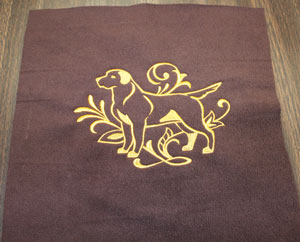
With the polyester chamois, I experimented with different design types, to see what types of designs this softer, stretchier fabric would support.
Using cutaway stabilizer, I began by stitching a design with open areas and lots of satin stitches. Would this be the most stitch-filled design the poly chamois could support? As you can see in the photo on the left, the Graceful Labrador Retriever design looks fabulous on this fabric.
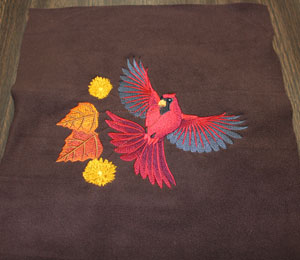
After success with a more open design, I decided to try stitching a more stitch-filled design on the poly chamois. Would it be able to support more stitch-filled areas? I loaded the Flying Cardinal with Autumn Leaves and Flowers onto my machine, and stitched it out. The results? Beautiful! Despite its slightly higher nap, and stretchiness, the polyester chamois supported this design very well.
The last variable I wanted to experiment with was what kind of stabilizer would work best with the polyester chamois. Would the stretchy nature of the poly chamois mean it needed the greater support of cutaway stabilizer? Or would tear-away stabilizer work as well as cutaway on this fabric? I chose the Owl and Flowers 1 design for my stabilizer test, as it had some smaller shapes as well as different stitch-filled areas.

The photo on the left shows the design stitched onto the cutaway stabilizer. The lines are crisp, the flowers are well-shaped, and the stitches look great!
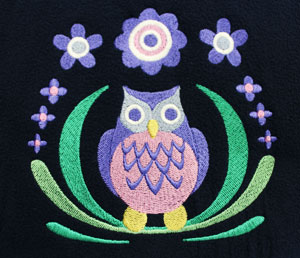
Next, I tried tear-away stabilizer (shown left). Compare the flowers at the top of the design to the flowers in the photo above. The flowers in the picture to the left are slightly misshapen. This is because tear-away stabilizer, with a stretchy polyester chamois, doesn't provide enough support for the stitches.
I used a sharp sewing needle (75/11) for this example. If I had used an embroidery needle, the difference would have been more noticeable. An embroidery needle would leave larger perforations in the tear-away stabilizer, allowing the fibers of the fabric to shift even more.
When embroidering on a stretchy fabric like polyester chamois, cutaway stabilizer provides the best support as the needle penetrates the fabric, and the design can better hold its shape.
Cutaway stabilizer will bring you the best results. But, if you must use a tear-away stabilizer, be sure to use a 75/11 sharp needle (as opposed to an embroidery needle) to minimize any shifting or skewing of the fabric fibers.
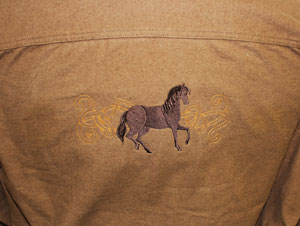
Whether you're stitching on cotton chamois or polyester chamois, with cutaway stabilizer, embroidering on these fabrics is a dream. So stitch one of your favorite designs onto a shirt or tote, or sew a cuddly quilt or blanket. Chamois is a terrific showcase for your embroidery!

